
Lublin is the ninth-largest city in Poland and the second-largest city of historical Lesser Poland. It is the capital and the centre of Lublin Voivodeship with a population of 336,339. Lublin is the largest Polish city east of the Vistula River and is about 170 km (106 mi) to the southeast of Warsaw by road.

Majdanek was a Nazi concentration and extermination camp built and operated by the SS on the outskirts of the city of Lublin during the German occupation of Poland in World War II. It had seven gas chambers, two wooden gallows, and some 227 structures in all, placing it among the largest of Nazi concentration camps. Although initially intended for forced labor rather than extermination, the camp was used to murder people on an industrial scale during Operation Reinhard, the German plan to murder all Polish Jews within their own occupied homeland. The camp, which operated from 1 October 1941 to 22 July 1944, was captured nearly intact. The rapid advance of the Soviet Red Army during Operation Bagration prevented the SS from destroying most of the camp's infrastructure, and Deputy Camp Commandant Anton Thernes failed to remove most incriminating evidence of war crimes.

Operation Harvest Festival was the murder of up to 43,000 Jews at the Majdanek, Poniatowa and Trawniki concentration camps by the SS, the Order Police battalions, and the Ukrainian Sonderdienst on 3–4 November 1943.

The Holocaust in Poland was part of the European-wide Holocaust organized by Nazi Germany and took place in German-occupied Poland. During the genocide, three million Polish Jews were murdered, half of all Jews murdered during the Holocaust.

Lubartów Ghetto was established by Nazi Germany in occupied Poland during World War II, and existed officially from 1941 until October 1942. The Polish Jews of the town of Lubartów were confined there initially. The ghetto inmates also included Jews deported from other cities in the vicinity including Lublin and Ciechanów and the rest of German-occupied Europe for the total of 3,500 Jews in its initial stages including 2,000 Jews from Slovakia. In May 1942 additional transport from Slovakia with 2,421 Jews arrived.
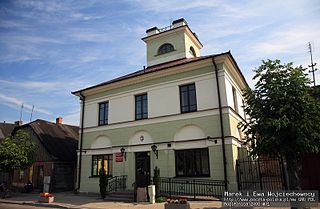
Mogielnica is a town in Grójec County in Masovian Voivodeship, Poland, with 2,475 inhabitants (2004) and an area of 141.56 square kilometres. It is the seat of Gmina Mogielnica. In other languages, it is referred to as Mogelnitsa, Mogelnitse, Mogelnitza and/or Mogielnicy.

The Częstochowa Ghetto uprising was an insurrection in Poland's Częstochowa Ghetto against German occupational forces during World War II. It took place in late June 1943, resulting in some 2,000 Jews being killed.

The Grodno Ghetto was a Nazi ghetto established in November 1941 by Nazi Germany in the city of Grodno for the purpose of persecution and exploitation of Jews in Western Belarus.

Radom Ghetto was a Nazi ghetto set up in March 1941 in the city of Radom during the Nazi occupation of Poland, for the purpose of persecution and exploitation of Polish Jews. It was closed off from the outside officially in April 1941. A year and a half later, the liquidation of the ghetto began in August 1942, and ended in July 1944, with approximately 30,000–32,000 victims deported aboard Holocaust trains to their deaths at the Treblinka extermination camp.
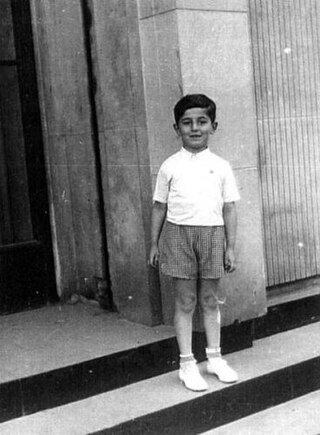
Henio Zytomirski was a Polish Jew born in Lublin, Poland, who was murdered at the age of 9 in a gas chamber at Majdanek concentration camp during the German Nazi occupation of Poland. Henio became an icon of the Holocaust, not only in Lublin but all over Poland. His life story became a part of the curriculum taught in the general education system in Poland. The "Letters to Henio" project has been held in Lublin since 2005. Henio Zytomirski is one of the heroes of "The Primer" permanent exhibition at barrack 53 of the Majdanek Museum, an exhibition dedicated to children held in the camp.
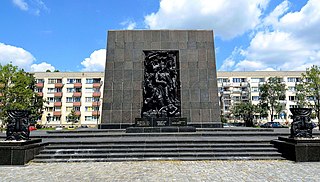
The Monument to the Ghetto Heroes is a monument in Warsaw, Poland, commemorating the Warsaw Ghetto Uprising of 1943 during the Second World War. It is located in the area which was formerly a part of the Warsaw Ghetto, at the spot where the first armed clash of the uprising took place.
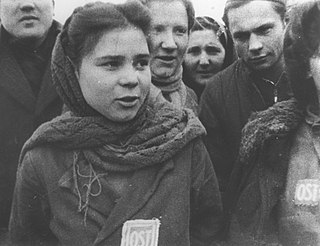
Ostindustrie GmbH was one of many industrial projects set up by the Nazi German Schutzstaffel (SS) using Jewish and Polish forced labor during World War II. Founded in March 1943 in German-occupied Poland, Osti operated confiscated Jewish and Polish prewar industrial enterprises, including foundries, textile plants, quarries and glassworks. Osti was headed by SS-Obersturmführer Max Horn, who was subordinated directly to Obergruppenführer Oswald Pohl of the SS Main Economic and Administrative Office. At its height, some 16,000 Jews and 1,000 Poles worked for the company, interned in a network of labor and concentration camps in the Lublin District of the semi-colonial General Government territory.
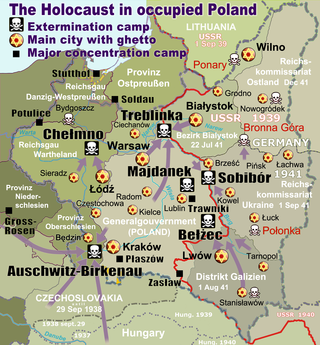
The Pińsk Ghetto was a Nazi ghetto created by Nazi Germany for the confinement of Jews living in the city of Pińsk, Western Belarus. Pińsk, located in eastern Poland, was occupied by the Red Army in 1939 and incorporated into the Byelorussian SSR. The city was captured by the Wehrmacht in Operation Barbarossa in July 1941; it was incorporated into the German Reichskommissariat Ukraine in autumn of 1941.

The Mińsk Mazowiecki Ghetto or the Mińsk Ghetto was a World War II ghetto set up by Nazi Germany in occupied Poland. Some 7,000 Polish Jews were imprisoned there from all neighbouring settlements for the purpose of persecution and exploitation. Two years later, beginning 21 August 1942 during the most deadly phase of the Holocaust in occupied Poland, they were rounded up – men, women and children – and deported to Treblinka extermination camp aboard Holocaust trains. In the process of Ghetto liquidation, some 1,300 Jews were summarily executed by the SS in the streets of Mińsk Mazowiecki.

The "Grodzka Gate – NN Theatre" Centre is a cultural institution based in Lublin. It is housed in the Grodzka Gate also known as the Jewish Gate that historically used to be a passage from the Christian to the Jewish part of the city. In its activities the Center focuses on issues of cultural heritage. The Polish-Jewish past of Lublin is the corner stone of the art and educational programmes carried out by the "Gate".

Frumka Płotnicka was a Polish resistance fighter during World War II; activist of the Jewish Fighting Organization (ŻOB) and member of the Labour Zionist organization Dror. She was one of the organizers of self-defence in the Warsaw Ghetto, and participant in the military preparations for the Warsaw Ghetto Uprising. Following the liquidation of the Ghetto, Płotnicka relocated to the Dąbrowa Basin in southern Poland. On the advice of Mordechai Anielewicz, Płotnicka organized a local chapter of ŻOB in Będzin with the active participation of Józef and Bolesław Kożuch as well as Cwi (Tzvi) Brandes, and soon thereafter witnessed the murderous liquidation of both Sosnowiec and Będzin Ghettos by the German authorities.

The Kielce Ghetto was a Jewish World War II ghetto created in 1941 by the Schutzstaffel (SS) in the Polish city of Kielce in the south-western region of the Second Polish Republic, occupied by German forces from 4 September 1939. Before the Nazi invasion of Poland in 1939, Kielce was the capital of the Kielce Voivodeship. The Germans incorporated the city into Distrikt Radom of the semi-colonial General Government territory. The liquidation of the ghetto took place in August 1942, with over 21,000 victims deported to their deaths at the Treblinka extermination camp, and several thousands more shot, face-to-face.
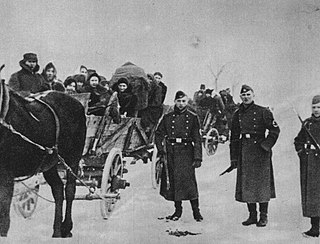
During the Holocaust, 99% of the Jews from Lublin District in the General Governorate of German-occupied Poland were murdered, along with thousands of Jews who had been deported to Lublin from elsewhere. There were three extermination camps in Lublin District, Sobibor, Belzec, and Majdanek.
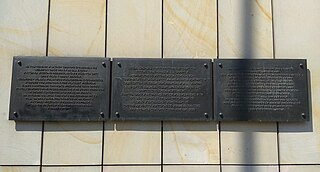
The Lipowa 7 camp was a Nazi forced labor concentration camp, primarily for Jews, by Lipowa Street in Lublin, Poland during December 1939 - 1944. In November 1943 nearly all Jewish inmates were exterminated.





















